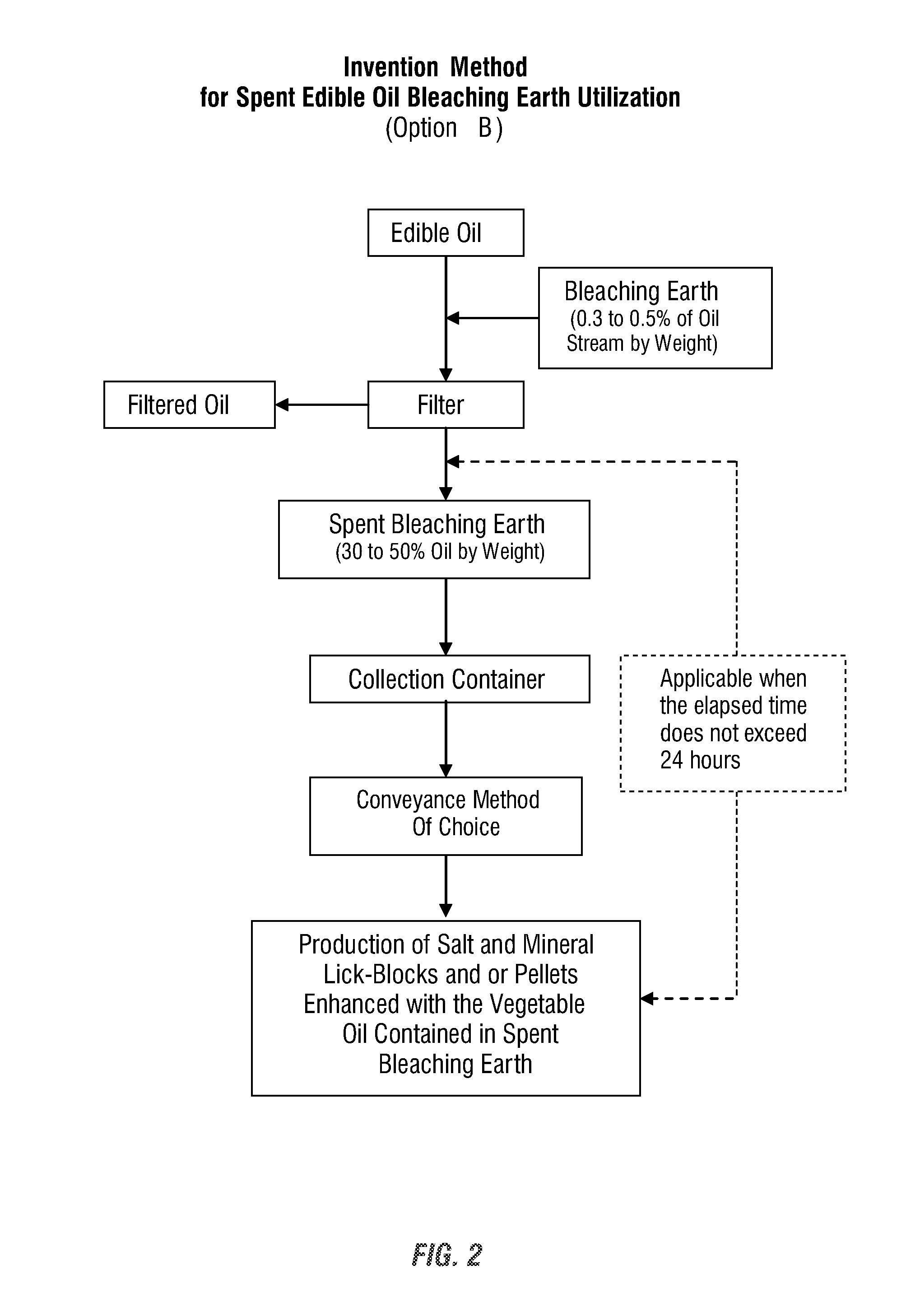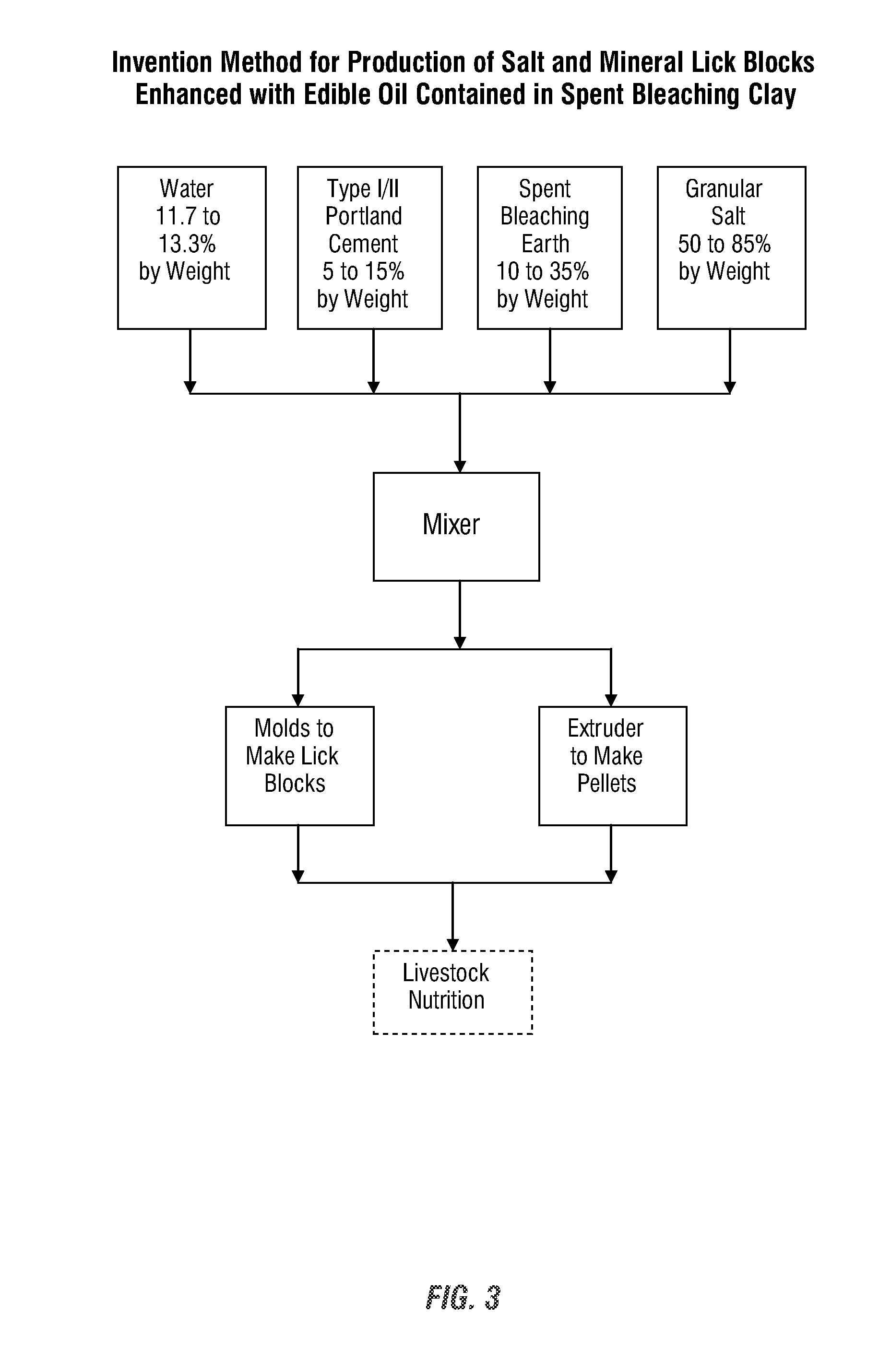Use of spent bleaching earth from edible oil processing in the formulation of salt and mineral feed blocks or pellets for livestock
a technology of edible oil and bleaching earth, which is applied in the field of livestock feed pellets and salt and mineral feed blocks or pellets, can solve the problems of limiting the storage stability of oil, generating enough heat to ignite oil, and wasting time on waste, so as to achieve safe dumping, more time for economic utilization, and elimination of spontaneous combustion
- Summary
- Abstract
- Description
- Claims
- Application Information
AI Technical Summary
Benefits of technology
Problems solved by technology
Method used
Image
Examples
example 1
[0053]Two animal lick block samples were prepared—a 1.573 liter rectangular-shaped block and a 4.732 liter bell-shaped block. A blend of attapulgite and bentonite spent bleaching earth from edible oil processing was obtained and combined with salt, Portland cement Type I / II, and water. The proportions combined were: 10 wt % spent bleaching earth, 85 wt % salt, 5 wt % Portland cement Type I / II, and 300 mL of water for the 1.573 liter block and 900 mL of water for the 4.732 liter block. A variable-speed shop drill motor with a mixer bit was used to thoroughly mix the ingredients. After thorough mixing, each mixture was transferred to a lick block mold. At this point, the mixtures had the color and consistency of concrete or mortar. The mixtures were allowed to set overnight in the molds. After setting overnight, the mixtures hardened and white salt crystals dominated their appearance. The 4.732 liter block was cured for ten days. The 1.573 liter block was cured for one week. During th...
example 2
[0054]Again, two animal lick block samples were prepared—a 1.573 liter rectangular-shaped block and a 4.732 liter bell-shaped block. A blend of attapulgite and bentonite spent bleaching earth from edible oil processing was obtained and combined with salt, Portland cement Type I / II, and water. The proportions combined were: 15 wt % spent bleaching earth, 75 wt % salt, 10 wt % Portland cement Type I / II, and 300 mL of water for the 1.573 liter block and 900 mL of water for the 4.732 liter block. A variable-speed shop drill motor with a mixer bit was used to thoroughly mix the ingredients. After thorough mixing, each mixture was transferred to a lick block mold. At this point, the mixtures had the color and consistency of concrete or mortar. The mixtures were allowed to set overnight in the molds. After setting overnight, the mixtures hardened and white salt crystals dominated their appearance. The 4.732 liter block was cured for ten days. The 1.573 liter block was cured for one week. D...
example 3
[0055]Again, two animal lick block samples were prepared—a 1.573 liter rectangular-shaped block and a 4.732 liter bell-shaped block. A blend of attapulgite and bentonite spent bleaching earth from edible oil processing was obtained and combined with salt, Portland cement Type I / II, and water. The proportions combined were: 20 wt % spent bleaching earth, 65 wt % salt, 15 wt % Portland cement Type I / II, and 300 mL of water for the 1.573 liter block and 900 mL of water for the 4.732 liter block. A variable-speed shop drill motor with a mixer bit was used to thoroughly mix the ingredients. After thorough mixing, each mixture was transferred to a lick block mold. At this point, the mixtures had the color and consistency of concrete or mortar. The mixtures were allowed to set overnight in the molds. After setting overnight, the mixtures hardened and white salt crystals dominated their appearance. The 4.732 liter block was cured for ten days. The 1.573 liter block was cured for one week. D...
PUM
 Login to View More
Login to View More Abstract
Description
Claims
Application Information
 Login to View More
Login to View More - R&D
- Intellectual Property
- Life Sciences
- Materials
- Tech Scout
- Unparalleled Data Quality
- Higher Quality Content
- 60% Fewer Hallucinations
Browse by: Latest US Patents, China's latest patents, Technical Efficacy Thesaurus, Application Domain, Technology Topic, Popular Technical Reports.
© 2025 PatSnap. All rights reserved.Legal|Privacy policy|Modern Slavery Act Transparency Statement|Sitemap|About US| Contact US: help@patsnap.com



